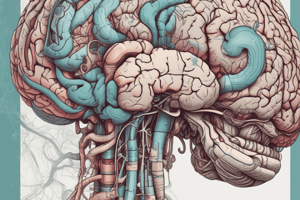Podcast
Questions and Answers
What is the main function of the brainstem?
What is the main function of the brainstem?
- Regulating heart rate
- Coordination of movement
- Processing sensory information
- All of the above (correct)
What structures make up the diencephalon?
What structures make up the diencephalon?
Epithalamus, thalamus, hypothalamus.
Which space is known as the fourth ventricle?
Which space is known as the fourth ventricle?
Fourth ventricle.
The ___________ attaches to the pituitary gland.
The ___________ attaches to the pituitary gland.
What is the main function of the pineal gland?
What is the main function of the pineal gland?
What three parts make up the brainstem?
What three parts make up the brainstem?
What region did the cerebrum form from?
What region did the cerebrum form from?
What region did the medulla oblongata form from?
What region did the medulla oblongata form from?
What region did the Pons and cerebellum form from?
What region did the Pons and cerebellum form from?
Flashcards are hidden until you start studying
Study Notes
Brainstem Overview
- The brainstem is a critical structure connecting the brain to the spinal cord, composed of the midbrain, pons, and medulla oblongata.
- It regulates essential functions such as breathing, heart rate, and sleep cycles.
Cerebral Aqueduct
- A narrow channel in the brain that connects the third and fourth ventricles, allowing cerebrospinal fluid (CSF) flow.
Cerebral Peduncle
- A structure in the midbrain that contains pathways connecting the brain to the spinal cord.
- Plays a vital role in motor function and coordination.
Cranial Nerves
- Twelve pairs of nerves that emerge directly from the brain, serving vital functions including sensory and motor control.
Decussation of the Pyramids
- The crossing over of motor fibers from one side of the brain to the opposite side of the body, crucial for contralateral control of voluntary movements.
Diencephalon
- Comprises the epithalamus, thalamus, and hypothalamus; responsible for sensory integration, regulation of body temperature, and link between the nervous and endocrine systems.
Fourth Ventricle
- A cavity situated between the brainstem and cerebellum that contains CSF, providing protection and nutrient transport.
Inferior Colliculi
- Paired structures involved in auditory processing and reflexive responses to sound.
Infundibulum
- A stalk-like structure that connects the hypothalamus to the pituitary gland, crucial for hormonal regulation.
Interthalamic Adhesion
- A mass of gray matter connecting the two thalami, acting as a relay point for sensory information.
Mammillary Bodies
- Small round structures of the hypothalamus, involved in memory processing and recognition.
Medulla Oblongata
- Part of the brainstem responsible for autonomic functions such as heartbeat and breathing regulation.
Mesencephalon
- Also known as the midbrain, it connects the forebrain and hindbrain, involved in vision, hearing, and motor control.
Nucleus Gracilis
- A medullary nucleus that processes sensory information from the lower body, part of the somatosensory pathway.
Oculomotor Nerve (CN III)
- Controls most eye movements, pupil size, and maintaining an open eyelid, crucial for vision.
Olive
- A structure in the medulla that plays a role in motor control and coordination.
Pineal Gland
- An endocrine gland that produces melatonin, regulating circadian rhythms and sleep patterns.
Pons
- A bridge that connects the cerebellum to the brainstem, relaying signals related to movement and sensory information.
Pyramids
- Structures on the ventral surface of the medulla containing motor fibers that descend from the cortex.
Red Nucleus
- A midbrain structure involved in motor coordination and regulation of muscle tone.
Reticular Formation
- A network of neurons that modulate various brain functions including consciousness, sleep, and alertness.
Substantia Nigra
- A region in the midbrain involved in reward, addiction, and movement. Degeneration is associated with Parkinson's disease.
Superior Colliculi
- Paired structures that play a pivotal role in visual processing and eye movement coordination.
Quadrigeminal Plate (Tectal Plate)
- Located on the dorsal aspect of the midbrain, it contains the superior and inferior colliculi, essential for processing visual and auditory information.
Thalamus
- The primary relay station for sensory information, directing it to the appropriate areas of the brain for further processing.
Brainstem Composition
- Comprised of the mesencephalon (midbrain), pons, and medulla oblongata.
Developmental Regions of the Brain
- The cerebrum originates from the telencephalon.
- The diencephalon forms the epithalamus, thalamus, and hypothalamus.
- The mesencephalon forms the cerebral peduncles, superior and inferior colliculi.
- The metencephalon forms the pons and cerebellum.
- The myelencephalon develops into the medulla oblongata.
Studying That Suits You
Use AI to generate personalized quizzes and flashcards to suit your learning preferences.



